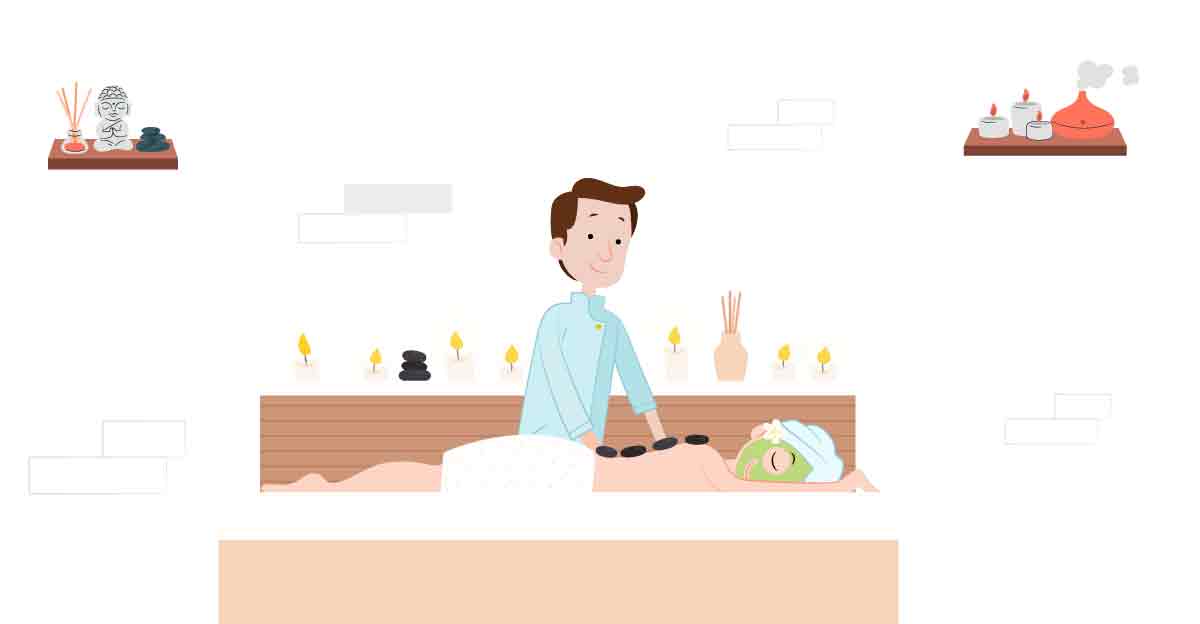Blending Essential Oils with Benefits in Aromatherapy Massage
Aromatherapy massage is not just a luxury; it’s a holistic approach to well-being that has been practiced for centuries. The fusion of aromatherapy and massage brings forth a unique experience that combines the benefits of touch therapy with the therapeutic properties of essential oils.
Choosing Quality Essential Oils
The success of aromatherapy massage lies in the quality of essential oils used. When selecting oils, ensure they are pure, organic, and free from additives. Popular choices include lavender, eucalyptus, and tea tree oil, each offering distinct benefits for a truly rejuvenating experience.
Purity and Origin:
Opt for essential oils that are pure and sourced from reputable suppliers.
Consider oils that are derived from organic plants, as they are less likely to contain harmful pesticides.
Additive-Free:
Ensure the selected oils are free from additives, synthetic fragrances, or diluents.
Pure essential oils are more potent and effective in delivering therapeutic benefits.
Research Each Oil’s Properties:
Different essential oils offer distinct benefits. Lavender is renowned for relaxation, eucalyptus for respiratory support, and tea tree oil for its antimicrobial properties.
Tailor your oil selection to the desired outcome of the massage session.
Allergies and Sensitivities:
Be mindful of any allergies or sensitivities the massage recipient may have.
Conduct a patch test or inquire about allergies before introducing a new essential oil.
Proper Blending:
Some massage therapists create custom blends to address specific concerns or preferences.
Understanding the art of blending ensures a harmonious combination of scents and therapeutic effects.
Benefits of Aroma Therapy Massage:

Beyond the sensory delight, aroma therapy massage has profound effects on both the body and mind. Stress relief, enhanced mood, and improved physical health are just a few of the many benefits that make this practice increasingly popular.
Stress Relief and Relaxation:
The massage itself helps to alleviate tension in muscles, promoting relaxation.
Aromatherapy enhances this effect by utilizing essential oils known for their stress-relieving properties, such as lavender or chamomile.
Emotional Well-being:
Certain essential oils have mood-enhancing properties, contributing to emotional well-being during and after the massage.
For example, citrus oils like bergamot or sweet orange are known for their uplifting effects.
Improved Sleep Quality:
Aromatherapy massage can aid in addressing sleep-related issues.
Essential oils like lavender have calming effects that may promote better sleep quality.
Pain Management:
Some essential oils, like peppermint or eucalyptus, have analgesic properties that can help manage pain.
When combined with massage, they can provide relief for sore muscles and joints.
Aromatherapy Essential Oils and Their Properties
Understanding the properties of aromatherapy essential oils is crucial for creating effective blends. For example, lavender promotes relaxation, while peppermint invigorates. Blending oils with complementary properties enhances their combined therapeutic effects.
Lavender (Lavandula angustifolia):
Properties:
Relaxation: Lavender is renowned for its calming and soothing effects on the nervous system.
Antidepressant: It possesses mood-enhancing properties, aiding in stress and anxiety reduction.
Analgesic: Lavender can help alleviate headaches and muscle aches.
Peppermint (Mentha piperita):
Properties:
Invigoration: Peppermint is energizing and invigorating, making it ideal for promoting alertness.
Pain Relief: Known for its analgesic properties, it can relieve muscle pain and headaches.
Respiratory Support: Peppermint can assist in clearing nasal passages and easing breathing.
Eucalyptus (Eucalyptus globulus):
Properties:
Respiratory Health: Eucalyptus is commonly used for respiratory support and clearing congestion.
Antimicrobial: It has antimicrobial properties, making it beneficial for immune support.
Mental Clarity: Eucalyptus can provide a sense of mental clarity and focus.
Tea Tree (Melaleuca alternifolia):
Properties:
Antimicrobial: Tea tree oil is a powerful antimicrobial agent, suitable for skin issues and immune support.
Anti-inflammatory: It has anti-inflammatory properties, making it useful for soothing skin irritations.
Cleansing: Tea tree oil is often used for its cleansing and purifying effects.
Bergamot (Citrus bergamia):
Properties:
Mood Elevation: Bergamot is known for its uplifting and mood-enhancing qualities.
Antidepressant: It can help alleviate feelings of stress, anxiety, and depression.
Skin Care: Bergamot is used in skincare for its soothing and balancing effects.
Chamomile (Matricaria chamomilla):
Properties:
Calming: Chamomile is highly calming and is often used to reduce stress and promote relaxation.
Anti-inflammatory: It has anti-inflammatory properties, beneficial for soothing skin conditions.
Sleep Aid: Chamomile is known to support restful sleep and alleviate insomnia.
Lemon (Citrus limon):
Properties:
Invigorating: Lemon has an invigorating and uplifting scent, promoting a positive mood.
Antibacterial: It possesses antibacterial properties, useful for cleansing and purifying.
Digestive Support: Lemon oil can aid in digestion and provide relief from nausea.
Aroma Massage Techniques
Aromatherapy massage employs various aroma massage techniques, from the gentle strokes of Swedish massage to the deeper pressure of a tissue massage. Learning basic techniques empowers individuals to incorporate aromatherapy into their self-care routines at home.
Swedish Massage Strokes:
Effleurage: Long, sweeping strokes that initiate the massage, promoting relaxation and improving blood circulation.
Petrissage: Kneading and squeezing motions that target deeper muscle layers, releasing tension and enhancing flexibility.
Tapotement: Light tapping or rhythmic percussive movements that invigorate muscles.
Friction: Circular motions that address muscle knots and stimulate blood flow.
Deep Tissue Massage:
Focused Pressure: Targets specific muscle groups, aiding in the release of chronic tension.
Cross-Fiber Friction: This breaks down adhesions and scar tissue, promoting better muscle function.
Trigger Point Therapy: Focuses on localized areas of pain or tightness for targeted relief.
Effleurage with Aromatherapy:
Oil Application: Combining the gentleness of effleurage with aromatherapy by using essential oil-infused massage oils.
Slow, Even Strokes: Enhance the soothing effect by employing slow and rhythmic movements, ensuring the even distribution of aromatic oils.
Hot Stone Massage:
Heated Stones: Placing warmed stones on key points relaxes muscles and enhances the overall massage experience.
Combined with Aromatherapy: Applying essential oils to the stones amplifies the sensory experience, blending warmth and fragrance.
Reflexology Techniques:
Foot Massage: Incorporating reflexology on the feet complements overall relaxation and well-being.
Aromatherapy Balms: Using aromatherapy-infused balms for foot massages can further enhance the therapeutic benefits.
Creating the Ideal Aromatherapy Atmosphere
Creating a relaxing ambiance is key to the success of aromatherapy massage. Dim lighting, soothing music, and the right essential oil scents set the stage for a truly immersive experience.
Dim Lighting:
Candles or Soft Lamps: Create a tranquil ambiance with soft, warm lighting to encourage relaxation.
Aromatherapy Diffusers: Use diffusers to disperse essential oils into the air, filling the space with a subtle, calming aroma.
Soothing Music:
Instrumental or Nature Sounds: Choose music that complements the massage experience, promoting relaxation and serenity.
Personalized Playlists: Tailor the music selection to individual preferences, enhancing the overall personalized experience.
Selection of Essential Oil Scents:
Custom Blends: Mix and match essential oils based on their properties and individual preferences for a tailored experience.
Calming Scents: Consider oils like lavender, chamomile, and frankincense for relaxation, and citrus oils for invigoration.
Safety Precautions in Aromatherapy Massage

While aromatherapy offers numerous benefits, it’s essential to use caution. Dilution guidelines, especially for potent oils, and awareness of contraindications for specific health conditions ensure a safe and enjoyable experience.
Dilution Guidelines:
Carrier Oils: Essential oils are highly concentrated and can cause irritation if applied directly to the skin. Always dilute them in a carrier oil (such as sweet almond or jojoba oil).
General Ratio: A common dilution ratio is 1-2% (1-2 drops of essential oil per teaspoon of carrier oil). Adjust based on individual sensitivity and the specific essential oil being used.
Patch Testing:
Allergies and Sensitivities: Before a full-body application, perform a patch test on a small area of skin to check for any adverse reactions or allergies.
Wait Time: Allow at least 24 hours to observe any delayed reactions.
Contraindications:
Medical Conditions: Be aware of contraindications for specific health conditions (e.g., pregnancy, epilepsy, high blood pressure) and avoid using certain oils in these cases.
Consultation: Before the massage, conduct a thorough consultation to gather information about the recipient’s health history.
Avoiding Photosensitive Oils:
Sun Exposure: Some essential oils, like citrus oils, can increase sensitivity to sunlight. Advise clients to avoid direct sunlight after a massage with photosensitive oils.
Informing Clients: Make clients aware of any photosensitive oils used and recommend sun protection.
Pregnancy Precautions:
Consultation: Pregnant individuals should consult with a healthcare professional before aromatherapy massage.
Safe Oils: Stick to pregnancy-safe essential oils, such as lavender or chamomile, and avoid those known to be potentially harmful.
The Link Between Aromatherapy and Mental Health
Aromatherapy has a profound impact on mental well-being. The calming effect of certain scents can alleviate symptoms of anxiety and depression, making it a valuable addition to mental health routines.
Calming Scents:
Lavender: Known for its calming properties, lavender can reduce stress and anxiety, promoting relaxation.
Chamomile: A gentle and soothing scent, chamomile can aid in calming the mind and easing tension.
Uplifting Scents:
Citrus Oils (Lemon, Orange): Citrus scents are invigorating and can help lift mood, providing a natural energy boost.
Peppermint: Known for its refreshing aroma, peppermint can enhance alertness and focus.
Stress Reduction:
Frankincense: Used for centuries, frankincense has grounding properties that can reduce stress and anxiety.
Ylang Ylang: This floral scent is associated with relaxation and can help lower stress levels.
Anxiety Relief:
Bergamot: Bergamot has both calming and uplifting effects, making it effective in alleviating symptoms of anxiety.
Rosemary: Known for its cognitive-enhancing properties, rosemary can help reduce anxiety and improve mental clarity.
Improved Sleep Quality:
Lavender: In addition to its calming effects, lavender is often used to promote better sleep quality, making it beneficial for individuals dealing with insomnia or sleep disturbances.
Mind-Body Connection:
Aromatherapy Massage: Combining aromatherapy with massage enhances the mind-body connection. The touch therapy of massage coupled with calming scents can provide a holistic approach to mental well-being.
Conclusion
The connection between aromatherapy and mental health is profound, with various scents offering therapeutic benefits for emotional well-being. Whether seeking relaxation, stress reduction, or improved mood, aromatherapy provides a natural and accessible avenue for mental health support. Incorporating aromatherapy into daily routines, whether through diffusers, topical applications, or massage, can contribute to a more balanced and resilient mental state.
